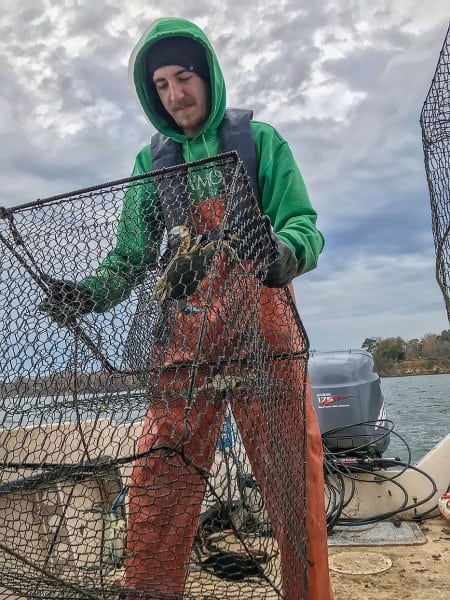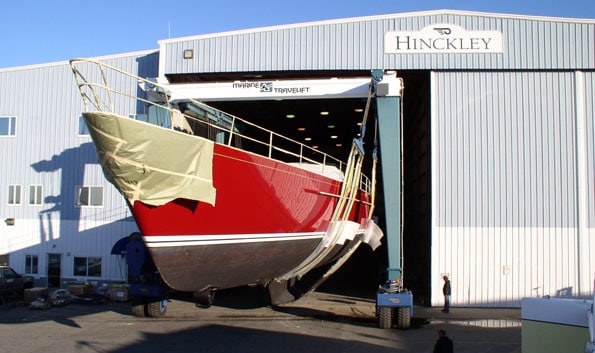Harvest in traps placed close together yield the same catch as those placed far apart.
By Jeremy Cox, Bay Journal News Service
Kyle Wood hauled the metal cage up from its resting place at the bottom of the Patuxent River in Maryland.
There was no telling how many blue crabs it held until the crab pot broke the surface. Wood shook the cage over a black plastic tray until the nine crabs inside finished tumbling out.
He picked them up one by one with a gloved hand and called out their gender to his two crewmates. Then, he used a metal ruler to measure them from one far tip of the shell to the other.
Eight were big enough for keeping, perhaps to be boiled and eaten over a paper tablecloth at a seafood joint in Baltimore or beyond. But that was not to be these crabs’ destiny.
Wood is an undergraduate student at the College of Southern Maryland, but his work on this overcast November morning was part of a study led by Morgan State University. Along with two veteran Chesapeake Bay researchers, he is hoping to inject some science into what heretofore has been an art: determining how far apart crab pots should be placed from one another.
That is, if the crabs were willing to give up their secrets. And that was anything but assured.
Crab pots are end-table-size traps with a funnel that allows the catch to enter but not escape. They are the backbone of the Bay’s commercial crabbing industry — some watermen fish several hundred at a time to make a living.
Tom Ihde is a fisheries ecologist at Morgan State as well as Wood’s mentor and co-author on the study. He has long wondered if the pots compete for the same crabs if they’re placed too close to each other. But placing them too far apart could cause watermen to spend needless time and diesel on the water.
It isn’t merely an academic matter, Ihde said. At the height of the Bay’s crab season in the summer and early fall, the buoys marking the location of crab pots are often so thick “you have to zigzag around to get your boat through,” he said. Solving the aquatic mystery could save untold expenses in a region home to more than one-third of the nation’s blue crab catch, he said.
“Every little bit matters on the water,” said Ihde, who began studying the Bay as a graduate student in 1997. “The profit margins are small. Every little bit of fuel you can save by not traveling as far, all of that is going to help the bottom line.”
Two watermen contacted for this article, though, were skeptical that science can explain something as inscrutable as the whims of blue crabs.
When told about the Morgan State study, Blair Baltus laughed heartily. “Answer me one question: How much grant money did they get to do this?” he asked. “This is about the most entertaining story I’ve heard of in my whole life.”
(Morgan State dipped into its own funds to cover the study, Ihde said. No grants were used.)
A lifelong crabber, the Baltimore County-based Baltus said it costs him $600 a day for bait, fuel and hired help, a figure that doesn’t include health insurance, boat maintenance, gear and other costs. But a robust rise in crab abundance — scientists estimate nearly 600 million crabs populated the Bay before last season began and the highest total since 2012 — helped to keep his business afloat.
“I can tell you three things” about crabs, Baltus said. “They swim, they feed every now and then and they taste good. Other than that, everything else about a Chesapeake blue crab is a hypothesis.”
Bill Kilinski, a Charles County waterman, called the study an “interesting concept,” but he also doubted that it would bear fruit.
For his part, Kilinski keeps things simple on the water. If crabs are plentiful in an area, he makes sure his crab pots are plentiful, too.
“Normally, as a waterman, it kind of takes care of itself,” he said.
The crab pot study is a side project of the venerable blue crab population survey conducted annually by Morgan State’s Patuxent Environmental and Aquatic Research Laboratory (PEARL). The research, begun in 1968 and supported in recent years by Dominion Energy Solutions, represents one of the longest-running studies of marine populations in the world.
Wood graduated with an associate’s degree at the end of the fall semester and plans to enroll in the fisheries and wildlife biology program at Frostburg State University in the fall. He snagged an internship at PEARL last summer.
In Wood, Ihde found a fellow traveler with a curiosity about crab pots. They tried their study in the summer, but the results were fouled because of low dissolved oxygen conditions at one of the pot locations.
So, they tried again from September through November. They used eight crab pots. Four were spaced a half-mile apart from one another, far enough to theoretically simulate harvesting crabs without interference from other pots.
To test the opposite scenario, the team lashed one pot to another, then repeated the process with the two remaining pots. Those “paired” traps were lowered into the water in separate locations.
They conducted the experiment in the Patuxent River, a Chesapeake Bay tributary, about three miles upstream from Maryland Route 4 bridge near the town of Solomons. They didn’t have to worry about commercial traps getting in their way because the state prohibits commercial fishermen from using crab pots in Bay tributaries. Using crab pots for research purposes is allowed.
“It’s a near-perfect laboratory for us,” Ihde said.
The study involved setting the pots by boat nine times over the course of the three months and checking them about 24 hours later for crabs. Wood tossed any crabs they caught back into the water after performing his check.
If the team’s research showed a difference between the two types of pot settings, their reward would be getting to do more research. They planned to conduct a second phase, cataloging catches at varying pot distances to determine which yields the most crustaceans.
But the second phase wasn’t needed. By early December, the results were in. The watermen appeared to be right. There was no difference between the paired pots and their far-apart cousins, according to Ihde’s initial review of the data.
“They’re not the results we expected or thought we’d see, but they’re results,” Ihde said. “From a scientific perspective, though, that’s exactly what the process is supposed to do.”
Maybe blue crabs don’t care whether traps are nestled tightly together or flung widely across the Bay’s dusky floor. Because the study was conducted in the fall, when crabs are migrating, the time of year may have affected the results, Ihde said, adding that he might test the question again during a future summer.




